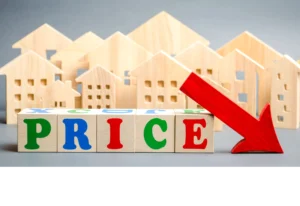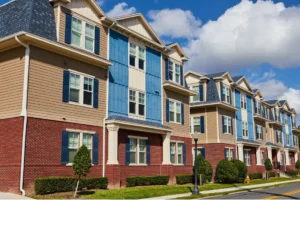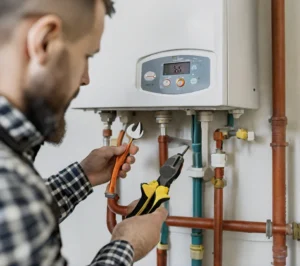Home·Property Management·How to Buy a Multifamily Property With FHA
Dreaming of owning a multifamily property?

How to Buy a Multifamily Property With FHA
Dreaming of owning a multifamily property but worried about the upfront costs or strict lending criteria? FHA loans might be the key to unlocking that dream.
These government-backed loans offer a low down payment option and more lenient credit requirements, making them a favorite for aspiring multifamily investors.
Plus, they allow you to offset your mortgage costs with rental income, a massive advantage for first-time buyers or seasoned investors alike. Whether you’re aiming to house hack or build equity in real estate, FHA loans provide an accessible pathway.
Let’s explore how these loans can help you secure a multifamily property, maximize affordability, and create a steady income stream.
Key Takeaways
-
FHA loans allow you to buy a multifamily property with a low down payment
-
You must live in one unit of the property to qualify for the loan
-
This strategy can help offset your mortgage costs with rental income
Understanding FHA Loans
FHA loans offer unique benefits for multifamily property buyers. These government-backed mortgages have less strict requirements than conventional loans, making homeownership more accessible. Let’s explore the key aspects of FHA loans for multifamily investments.
FHA Loan Basics
FHA loans are mortgages insured by the Federal Housing Administration. They’re designed to help buyers with lower credit scores or limited funds for down payments. For multifamily properties, you can purchase buildings with up to four units.
The catch? You must live in one of the units as your primary residence. This owner-occupancy rule makes FHA loans perfect for house hacking – living in one unit while renting out the others.
FHA loans typically require a down payment of just 3.5% of the purchase price. This low upfront cost can be a game-changer for many investors.
Credit Requirements and Scores
Your credit score plays a big role in FHA loan approval. The minimum FICO score for FHA loans is 580 with a 3.5% down payment. If your score is between 500-579, you’ll need a 10% down payment.
But don’t worry if your credit isn’t perfect. FHA loans are more forgiving of past financial hiccups than conventional mortgages. They consider your overall financial picture, not just your credit score.
Tips to boost your chances of approval:
-
Pay bills on time
-
Lower your credit card balances
-
Avoid new credit applications before applying
Get a Free Multifamily Loan Quote
Access Non-Recourse, 10+ Year Fixed, 30-Year Amortization
FHA Loan Limits
FHA loan limits vary by location and property type. In 2024, the base limit for a single-unit property is $472,030 in most areas. For a four-unit property, it rises to $907,900.
High-cost areas have higher limits. In pricey markets like San Francisco or New York City, the four-unit limit can exceed $2 million.
These limits change annually, so stay updated. Check the HUD website for current limits in your target area.
Mortgage Insurance Premiums
FHA loans require two types of mortgage insurance:
-
Upfront Mortgage Insurance Premium (UFMIP): 1.75% of the loan amount, paid at closing
-
Annual Mortgage Insurance Premium (MIP): 0.45% to 1.05% of the loan amount, paid monthly
The exact MIP rate depends on your loan term, amount, and down payment. Unlike conventional loans, FHA mortgage insurance is required for the life of the loan in most cases.
While this adds to your monthly costs, it’s often offset by the lower interest rates FHA loans offer.
Comparing FHA and Conventional Loans
FHA loans shine for multifamily investors with less-than-perfect credit or limited cash.
Here’s how they stack up against conventional loans:
| Feature | FHA Loan | Conventional Loan |
|
Min. Credit Score |
580 (3.5% down) |
620-640 |
|
Down Payment |
3.5-10% |
3-20% |
|
Max Units |
4 |
No limit |
|
Owner Occupancy |
Required |
Not required |
|
Mortgage Insurance |
Required |
Optional (with 20% down) |
FHA loans offer easier qualification and lower down payments. But conventional loans give more flexibility for pure investment properties.
Your choice depends on your financial situation and investment goals. FHA loans can be a smart way to start your multifamily journey, especially if you’re willing to live in one unit.
Preparation for FHA Multifamily Loan
Getting ready for an FHA multifamily loan takes some work. You’ll need to check your finances and learn about different loan options. This step is key to a smooth process.
Assessing Financial Health
Your Debt-to-Income Ratio (DTI) is crucial for the FHA loan program. It shows if you can handle the mortgage payment. Aim for a DTI below 43%. Check your credit score too – you need at least 580 for a 3.5% down payment.
Look at your savings. You’ll need cash for the down payment and closing costs. Don’t forget about reserves. FHA wants to see you have money for unexpected expenses.
Review your income. Lenders will check your job history and earnings. They like to see steady income for at least two years. If you’re self-employed, get your tax returns ready.
Understanding Multifamily Loan Options
FHA multifamily loans let you buy properties with up to four units. You must live in one unit as your main home. The other units can be rented out.
Know the FHA multifamily loan limits. They vary by area and property type. In 2024, limits range from $472,030 for a duplex to $907,900 for a four-unit property in high-cost areas.
Compare FHA loans to commercial loans. FHA loans often have lower rates and easier terms. But they come with rules about living in the property. Commercial loans might offer more flexibility for investors.
Talk to a HUD-approved lender. They can explain the ins and outs of FHA multifamily loans. They’ll help you understand if this loan type fits your goals.
Selecting the Right Multifamily Property
Choosing the perfect multifamily property for an FHA loan requires careful consideration. You’ll need to evaluate different property types, meet FHA standards, and understand how rental income factors into your investment.
Evaluating Property Types
Multifamily homes come in various forms. You can choose from duplexes, triplexes, or fourplexes. Each type has its pros and cons.
Duplexes are easier to manage but generate less rental income. Fourplexes offer more income potential but require more upkeep.
Consider your management skills and time availability. If you’re new to real estate, start with a smaller property.
Owner-occupied multifamily properties are ideal for FHA loans. You can live in one unit and rent out the others.
Appraisal and FHA Standards
FHA loans have strict property standards. Your chosen property must pass an FHA appraisal.
The appraiser checks for safety, security, and soundness. They look at the roof, electrical systems, and plumbing.
Any issues must be fixed before loan approval. This protects both you and the lender.
FHA standards also cover affordable housing and condominiums. Make sure your property meets these guidelines.
Calculating Rental Income
Rental income is a key factor in multifamily investing. You need to estimate potential earnings accurately.
Start by researching fair market rental values in your area. Look at similar properties to gauge rental rates.
FHA loans allow you to use projected rental income to qualify for the mortgage. This can help you afford a larger property.
Remember, vacancies and maintenance costs will impact your actual income. Be conservative in your estimates to avoid financial strain.
Navigating the FHA Loan Process
Getting an FHA loan for a multifamily property takes some work. You’ll need to gather documents, follow rules, and meet specific requirements. Let’s break down the key steps.
Loan Application and Documentation
The FHA loan process starts with your application. You’ll need to provide proof of income, employment history, and assets. Bank statements, tax returns, and pay stubs are crucial. Don’t forget your photo ID and Social Security number.
For multifamily properties, you must show you’ll live in one unit as your primary residence. This is a big deal for the FHA. They want owner-occupants, not just investors.
You’ll also need to prove the property meets FHA standards. This means getting an appraisal and inspection. Be ready for extra scrutiny on things like safety and condition.
Complying with Local Ordinances
Local rules can trip up your FHA loan plans. Each city has its own laws about multifamily homes. You need to know these before you buy.
Some areas limit the number of units allowed. Others have strict parking rules. Zoning laws can affect whether you can rent out units at all.
Check with your local housing department. They can tell you about permits, inspections, and other requirements. Don’t skip this step – it could save you headaches later.
Remember, FHA loans can be used for properties with up to four units. But local laws might be stricter. Always do your homework on both FHA and local rules.
After Purchase Considerations
Buying a multifamily property with an FHA loan is just the beginning. You’ll need to manage the property and think about your loan’s future. Here’s what you should keep in mind after closing the deal.
Managing Multifamily Residences
Managing multifamily residences is hard work. You’ll wear many hats as a landlord and property manager. First, set up a system for rent collection and maintenance requests. Consider using property management software to stay organized.
Screening tenants is crucial. Look for reliable renters who’ll pay on time and take care of the units. Be ready to handle repairs quickly. This keeps tenants happy and protects your investment.
House hacking can help offset costs. Live in one unit and rent out the others. This strategy works well with FHA loans, which require you to live in the property.
Don’t forget about rental assistance programs. They can help fill vacancies and provide steady income. Check local and federal options to see what’s available in your area.
Exploring Refinancing and Loan Terms
Your FHA loan won’t last forever. After a few years, you might want to refinance. This can lower your interest rate or get rid of mortgage insurance.
Keep an eye on market rates. When they drop, it might be time to refinance. You could switch to a conventional loan if your credit has improved. This often means lower monthly payments.
Watch out for prepayment penalties. Some loans charge fees if you pay off early. FHA loans typically don’t have these, but it’s good to check.
Refinancing can also let you cash out equity. Use this money for renovations or to buy another property. Just be careful not to overextend yourself.
Frequently Asked Questions About FHA Loan for Multifamily Property
What are the FHA loan guidelines for purchasing a multifamily home?
FHA loan guidelines for multifamily homes allow you to buy properties with up to four units. You must live in one of the units as your primary residence. The property needs to meet FHA standards and pass an appraisal. Your credit score should be at least 580, and you’ll need to prove steady income.
What is the maximum loan limit for an FHA multifamily property?
The maximum FHA loan limit for multifamily properties varies by location and number of units. In 2024, limits range from $472,030 for a two-unit property in low-cost areas to $1,867,275 for a four-unit property in high-cost areas. Check the FHA website for current limits in your area.
How much down payment is required for an FHA multifamily mortgage?
The minimum down payment for an FHA multifamily mortgage is 3.5% of the purchase price. This low down payment makes it easier for you to enter the multifamily market. Remember, you’ll also need to budget for closing costs and mortgage insurance premiums.
Are first-time home buyers eligible to buy a multifamily home using an FHA loan?
Yes, first-time home buyers can absolutely use FHA loans for multifamily homes. In fact, it’s a great way to start building wealth. You’ll live in one unit and rent out the others, potentially covering your mortgage payment. Just make sure you’re ready for the responsibilities of being a landlord.
Can an FHA loan be used to purchase a rental property?
FHA financing through residential loans can be used to buy multifamily properties as investment opportunities. However, you must occupy one unit as your primary residence for at least one year. After that, you can move out and rent all units if you choose.
What is the FHA rule regarding the purchase of a 3-unit property?
When buying a 3-unit property with an FHA loan, you must live in one unit. The other two can be rented out. You’ll need to meet credit score requirements and income guidelines. The property must pass an FHA appraisal and meet safety standards. This setup can be a great way to start your real estate portfolio.
Can I Buy a Multifamily Home With an FHA Loan – Conclusion
FHA residential loans open doors to multifamily property ownership with minimal upfront costs and flexible credit requirements.
By requiring owner occupancy, they allow you to live in one unit while generating income from the others.
Understanding key aspects like loan limits, credit score requirements, and property standards ensures a smoother path to approval and ownership. With proper planning, FHA loans can help you balance affordability with investment growth.
Source: Willowdale Equity
Get AAOA's Newsletter
Property Management News Categories
- Affordable Housing
- Collections
- COVID-19
- Eviction
- Fair Housing
- Financing
- Going Green
- Government
- Investing
- Landlord Forms
- Landlord Quick Tips
- Latest News
- Leasing
- Legal Brief
- Legal News
- Maintenance
- Make Extra Money
- Marketing Vacant Units
- Property Management
- Real Estate Investing
- Real Estate Trends
- Remodel and Repair
- Rent Magazine
- Security Deposit Alternatives
- Social Media
- Tax Tips
- Technology
- Tenant Screening
- Uncategorized













 Accessibility
Accessibility